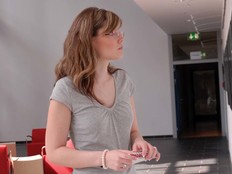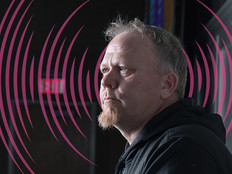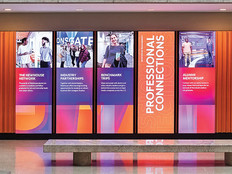Video's New World Order
At Duke University's Fuqua School of Business in Durham, N.C., a new telepresence system is breaking geographic boundaries, allowing faculty, students and expert speakers from all over the world to collaborate in exciting new ways.
With telepresence, a trade official in India can speak to students in Durham without having to travel halfway around the world – and without losing the immersive experience of a face-to-face visit.
Duke partnered with Cisco Systems to design one of the first auditorium-based telepresence systems. Cisco TelePresence uses high-definition video and high-quality audio to create an image of such clarity that people could almost believe they are in the same room together.
For one of the first presentations last year, Duke had John Chambers, Cisco's chairman and CEO, and John Doerr, partner at venture capital firm Kleiner Perkins Caufield & Byers, deliver a master class on innovation.
“I was in India with a group of students while Chambers and Doerr were in California, and both sites were linked to the auditorium at Fuqua's campus in Durham, but it felt like they were interacting in the same place at the same time,” says Tony O'Driscoll, executive director of the Fuqua School's Center for Technology, Entertainment and Media.
“My students were saying they felt like they were there,” O'Driscoll says. “The sense of the presence that this technology provides truly makes geography history.”
Fuqua's dean, Blair Sheppard, adds that telepresence has great potential to expand global business education.
“The Cisco TelePresence system allows a new kind of face-to-face interaction for a new era in business,” Sheppard says. “The system is aptly named, as it allows participants a presence that has simply been impossible without getting on a plane and flying around the globe.”
The Duke Difference
The Fuqua School's Cross Continent MBA program has 160 students representing more than 25 countries – a very sophisticated global audience that is seeking something more than the standard course offerings.
The school recently broke ground on a campus in Kunshan, China, and is also planning to develop a presence in Delhi, India; Dubai, United Arab Emirates; London; and St. Petersburg, Russia. That expansion is compelling the business school to offer CEO-level speakers and experts wherever the school offers programs.
The telepresence auditorium in Durham holds up to 120 people. It has three 103-inch plasma screens, with the middle screen typically featuring the person who is speaking.
“Whenever someone talks in the audience, the camera pans onto that person and zooms in on the individual so you can see their expressions and you feel instantly connected to them,” O'Driscoll explains.
The auditorium also has six 1080-pixel cameras that create panoramic and lifesize visuals; an instructor's podium with two document cameras that are used to share class materials; three remote student displays so the instructor can view remote classrooms from the podium; and 65 custom push-to-talk microphones for interactive discussions.
One of the more interesting aspects of the system is the inclusion of a special mat that the speaker stands on so the cameras can follow the person's movements (as opposed to a traditional telepresence conference room in which the participants are seated).
“Most professors like to walk around, so we had to improvise around that,” O'Driscoll says. “Cameras were programmed to automatically follow the movements of the professor as they moved around on a pressure mat on the floor.''
Telepresence is also an especially useful selling point to attract high-level executives to participate in lectures, O'Driscoll says.
“To get world leaders to travel to one of our program locations can be a challenge,” he says. “Telepresence gives us the ability to engage world leaders without them having to burn jet fuel or spend unnecessary time on travel, so it's about ease of access.”
Roopam Jain, a principal analyst at Frost & Sullivan, agrees, adding that organizations facing budgetary challenges are looking for technologies that will help them reduce travel costs.
“They are looking for technologies [that help them] communicate with global teams,” says Jain, who adds that green initiatives also play into the push to deploy telepresence.
Constant Communication
The California Institute for Telecommunications and Information Technology, a research institute that is part of the University of California San Diego, also uses telepresence. The group uses the technology to test and demonstrate the capabilities and limits of networks.
Using LifeSize high-definition video conferencing systems (Room 220 and 100), researchers, staff and students at the institute communicate and partner with other institutions around the country and globally.
While the institute celebrated its 10th anniversary in December 2010, it wasn't until five years ago – when the staff moved into its new headquarters in San Diego – that it became clear that standard video conferencing systems would not be sufficient.
“Because we wanted to push the boundaries of the network, we wanted something with better quality and chose to use LifeSize as our video conferencing tools because they were the only ones with high-definition quality then,'' says Hector Bracho, media technology resources manager.
LifeSize Room 220 is an enterprisewide product with cameras, monitors and a multipoint bridge embedded for use by eight other participants at separate sites, Bracho says. The system has a split-screen feature that lets users see up to four people on a display.
47%
The return on investment over a five-year period that global organizations report from telepresence
SOURCE: Forrester Research
The institute has about 800 researchers who conduct meetings between the campuses in Irvine and San Diego, and with other researchers around the world. At UCSD, the systems in the nine LifeSize rooms let them communicate with anyone, anywhere, who has a similar system. The institute has a room with 70 computer displays attached together, known as the “HIPerSpace wall,” which lets users see huge amounts of data all at once or a single, very large image across the monitors.
Bracho says he and the staff have been doing a lot of research on data handling – what happens when the system grabs the information and shows it on the display walls. The institute then helps other universities build display walls so people can view shared data in ways not possible with a standard computer monitor in a more immersive setting. Without the telepresence system, collaborative work would have required travel, Bracho says.
“That was the top reason for deploying these units,” he says. “It's almost a necessity to have a video system, and the [reduction in] travel and time wasted have been a great benefit. As a public university with a shortage of funds, it's been a good investment.”

Photo: David Arky/Photolibrary
Planning for Telepresence
Assuming a college or university already has the network infrastructure, the hardware required for a telepresence system includes cameras connected to plasma displays and acoustics. Systems can range in price from $100,000 up to $400,000 for a complete studio setup. There is also a recurring monthly fee that ranges from a few thousand dollars to nearly $18,000, depending on the level of service and the amount of network bandwidth that is required. The cost also depends on the size of the room and whether the system will be hosted or managed by in-house IT staff.






